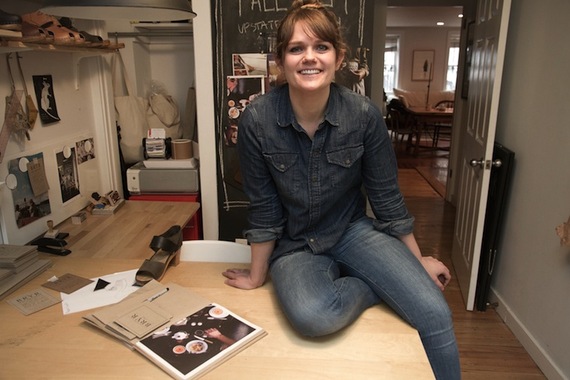Last winter, while talking to one of our designers, Isobel Schofield of Bryr Clogs, it hit me how many of us still sit at our corporate desk jobs dream of creating a life that gives us more freedom and control.
"When I was in my 20's, the idea of becoming a design director working at a major US brand seemed like a pipe dream. But, after working steadily towards that goal for my whole career, when I actually reached that milestone I found something was missing. Somehow, I'd gone off track. What I was doing with my life was not in line with my values. I day-dreamed of being in a little studio somewhere, working with a small team, having a relationship with my customers and making something with my hands that I felt really proud of", said Isobel.
I understood exactly what she was saying. I had been there myself. In fact, many of us share an innate desire to nurture our souls and make a living involving our creativity. But, most of us don't even know when or where to start. How do you get on this path today? How do you make a plan that steadily moves you in the right direction? How do you avoid making impulsive big moves, which might harm your career or finances?
In this six (6) part series, I'll share a roadmap with you that has worked for me as well as many of the designers I work with at Madesmith and Madesmith Academy. Since, we talk to hundreds of makers to promote them and tell their stories, as well as offer education from designers who have created successful brands themselves, we've gathered strategies and lessons that work.
So, if you're sitting at your desk and dreaming about starting a creative business, you don't have to let another year slip by. You can start taking steps today that will set you in the right direction. Make sure to tweak this plan as you go, keep a diary of all the details, and track progress.
Phase 1: Launch minus 12 months
This is the phase where you get to start making 'one day' into 'now'. Even if you don't know what exactly what type of business you will be creating for yourself, the only way to make it all happen is by start taking action. The three (3) most important activities in this phase are networking, skill development, and financial readiness.
1. Network
The most important goal during this phase should be to get inspired and gain momentum for your own launch. The best way to do this is by surrounding yourself with people who are on entrepreneurial journey and can provide you with encouragement as well as answer your questions. Focus on listing the goals you want to achieve by meeting what type of person. Then carefully select in-person events near you or online network groups. One of my favorite organizations is Ellevate (formerly known as 85 Broads), a global organization of professional women that organizes in person and online events. If you're in the market for a technology startup, another good resource is Women 2.0. If you don't live in a large city and don't have access to any of these organizations, you can start your own Meetup or find a group online (there are many on Facebook and Meetup). Find one group that fits your needs and make sure to take full advantage of all it has to offer. Once at the gathering, listen intently, ask questions and absorb as much as you can. Take copious notes when you get home so that you can refer to them later.
Your goal should not be to meet as many people as possible; rather you should be focused on making quality connections. Once you identify who the most important connections are, follow-up and transform these connections into relationships. One way to nurture these relationships is by offering your expertise or a meaningful introduction to perhaps a potential client in return for answers to your questions or other introductions you might need.
In the meantime, continue to do an excellent job at your work. The feeling of accomplishment and productivity at your day job will serve you in a positive manner in your own business preparation. It will help you minimize stress from that part of your life. However, try not to miss any events or meetings that will serve your long-term goal. It is really about prioritization and time management. And, it gets better with practice.
2. Develop your skills
As I mentioned earlier, even if you don't know exactly what type of business you are looking to create, the only way to find out is through experiencing. In addition to the creative skills, you also need to be proficient in the business skills as well such branding, marketing and pricing etc. Otherwise, the business does not have much of a chance to survive. In almost every case, just creating beautiful creative work or product alone will not garner you customers. You have to learn to market it and manage your business finances well in order to be successful.
Depending on your current knowledge, take a weekend creative and/or business class near you e.g. at a community college, or local arts center or an online academy. An important thing to make sure is that you take a class that not only provides you with technical skills but also provides you inspiration through a like-minded community and ideally good design aesthetic. I've taken many classes online, which provide good technical know-how, but don't necessarily get me excited to do the craft day in day out.
Another really great way to learn skills first hand is by offering to apprentice with a local designer or shop that you admire. You can do this during weekends and it won't cost you money. But, make sure that you clarify your goals for the apprenticeship upfront so that you get assigned the right tasks.
3. Save. Save. Save.
One of the biggest reasons small businesses shut down is due to lack of cash. No matter what you think you will need, money goes out much faster than it comes in. I would recommend having at least 8-12 months (from when you leave your job) worth of living expenses in your savings, along with 4-6 months of runway for business expenses once you launch. Create a tight budget and follow it diligently. Perhaps, you can motivate yourself by creating a mood board with magazine pictures of what success might look like for you. Visualizing the end goal makes your day-to-day prioritization and decision making much easier.
In the next installment of this series, I will show you how to put together a 1-page business plan that will help you launch. Stay tuned!

